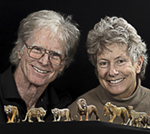Yellowstone Fall Photo Tour
2018 Trip Report

We offer the finest in small group wildlife and nature photography tours,
workshops and safaris, both domestic and foreign.
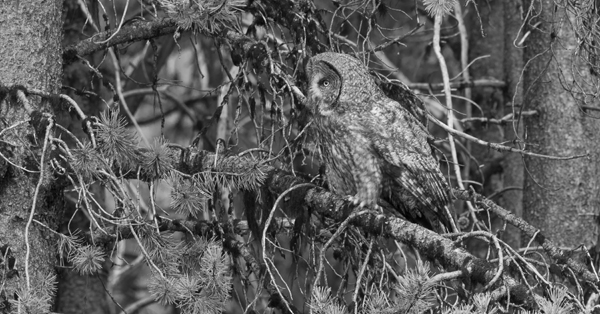
Our schedule required a shorter tour this year, of only four days, but it was an extremely productive one. The first week of October offers the threat of winter, and we were worried that snow might influence the trip. Luck was with us and the bad weather held off, allowing us to get to the spots we wanted to visit.
Mary and I used Olympus Mirrorless Cameras for the first time, as part of a pro-loaner program Olympus was doing. We had two complete kits, which required me to spend an entire day reading the on-line manual to understand the camera. Like most manuals, I was confused at times, but once mastered, I found the camera easy to use and the menus very useful.
These Olympus Cameras -- OM-D E Mark II -have a great image stabilization system, and to test it both Mary and I rarely used a tripod. This was a first for me, as I always use a tripod, but to be fair, or accurate, to the IS claim, hand-holding was best. I was impressed, and even with macro shots I obtained usable shots at slow shutter speeds -- really challenging any image stabilization system.
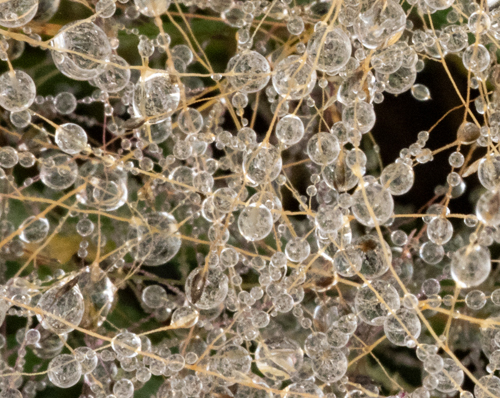
Water droplets on fine grasses. The mass of 'bubbles' reminded me of a jellyfish in a freshwater lake I've seen in a film. This image, shot with a macro, was hand-held at 1/160th sec at f22, ISO 1600.
In shooting our landscapes, I did several scenes where I planned to do a HDR merge, via Photoshop, but I found that the dynamic range of the RAW capture allowed me to either tone down brights, or pull up blacks, to capture the scene with one shot. That really impressed me too.
I shot the Tower Creek scenes, below, using a tripod, as my shutter speeds ranged from 1/8th to 1/3rd of a second. I exposed for the whites -- controlling that exposure, but in doing so the rocks and trees were very underexposed. In the RAW converter I brought back the dark areas -- a great example of dynamic range. Below, I've included the original and the finished shots - impressive.
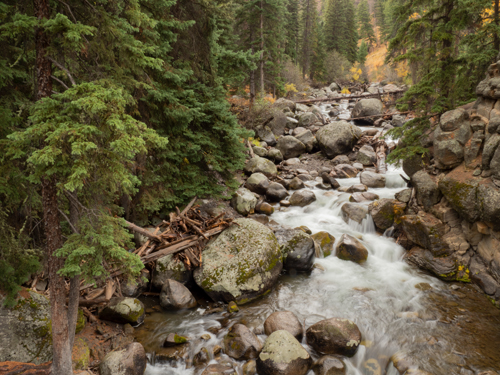
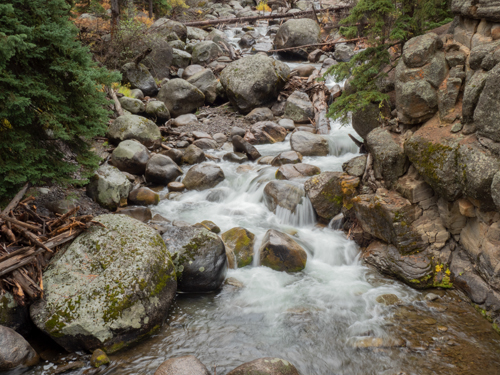
Tower Creek, at 1/3rd and 1/6th sec, f22 ISO 200.
In these exposures, if I exposed for the white water the surrounding rocks and trees where dark, and if I exposed for the rocks, the water was over-exposed.
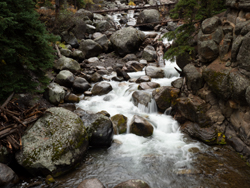
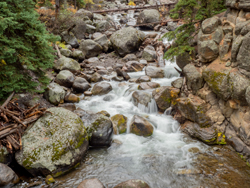
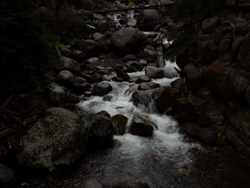
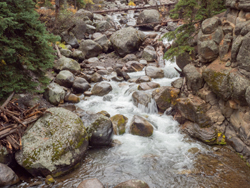
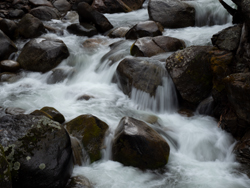
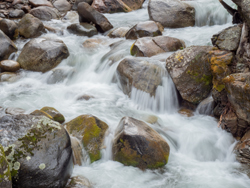
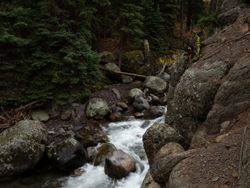
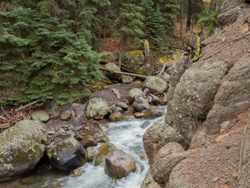
Here's the RAW shots (Left) and the shot after RAW conversion -
the larger images, above, were similar. Pretty good dynamic range!
It is always fun to be doing a tour with photographers who have not been to an area before, and that was the case this year. A few of our participants had visited Yellowstone many years earlier, and for the others it was new. And, for us, most of our participants were new to us, and it was wonderful to make new friends.
Here's the day-to-day report:
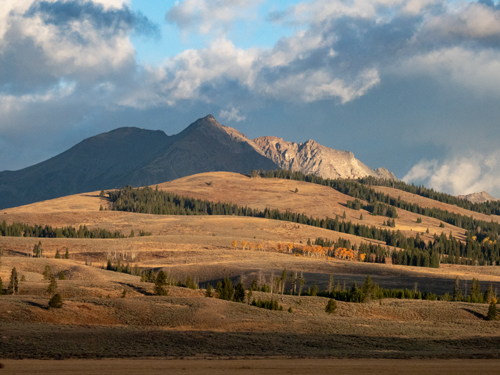
Electric Peak from the pull-off at Swan Lake Flats. Sadly, the trail leading to the lake shore is now closed. I assume the trail was closed in the spring nesting season and the signs never removed, blocking one of the prettiest scenic spots for photographers. Tundra Swans were visible, and in the past were easily photographed, as the birds were unconcerned. Now ... that is lost!
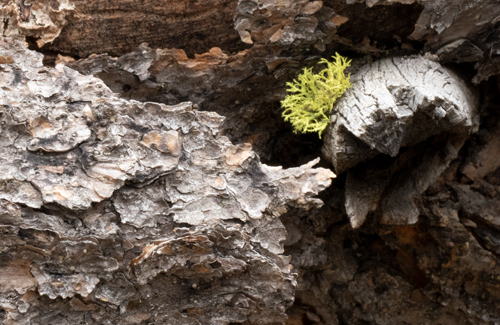
I used the focus composite feature of the Olympus, that does stacking in the camera
for this macro shot.

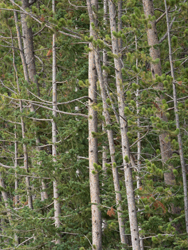
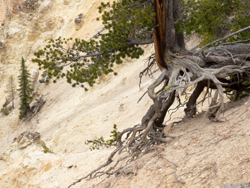
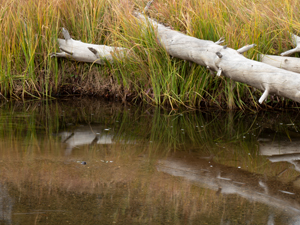
Day 1. We met some of our participants in Bozeman, then drove to 100 miles to Gardiner where we met the rest of the group. After a group dinner at a local restaurant we had our orientation meeting and slide show, discussing our plans for the week and our subjects. We concluded early, giving everyone time to get ready for our first day of shooting.
Day 2. We left at 6:25, hoping to get a sunrise at Swan Lake Flats but the sky was overcast. Most distressing, Swan Lake Flats was closed, with a sign saying that the area was closed to protect the birds and wildlife. I’d assume that sign was erected in spring, during nesting, but was never taken down, and now this beautiful area for scenic photography is closed. Criminal!
We headed south, stopping at a new visitor site with a boardwalk that leads to a pretty thermal and springs. Afterwards, we continued to Norris for breakfast, where a herd of Bison joined us, moving about and requiring us to shift positions constantly to keep our distance and to be safe. Eventually they moved off, 1.5 hours later.
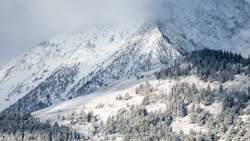
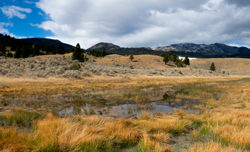
We drove on to Artist Point at the Grand Canyon for scenic, and while there Mary got a text that a Grizzly was spotted near Yellowstone lake. At the Pelican Flats area Mary spotted a Great Gray Owl, and we moved out across a broad field and marsh to look for the owl. Eventually we found it, and got decent photos, and attracted a huge crowd. When the masses arrived we left – hopefully leaving the owl in peace.
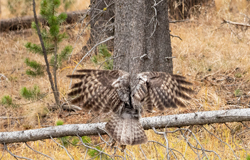
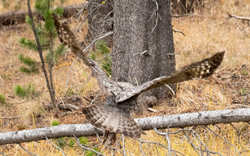
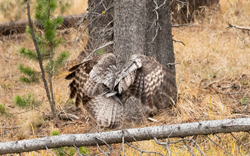
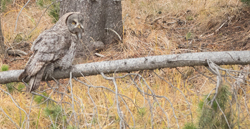
The Olympus has a 'pro capture' mode, where images are recorded when the shutter is pressed halfway, stopping when the shutter is fully pressed to capture action. This Great Gray Owl landed on the log, and I was using 'pro capture', but unfortunately the bird was facing away from me. Still, you can see how this works.
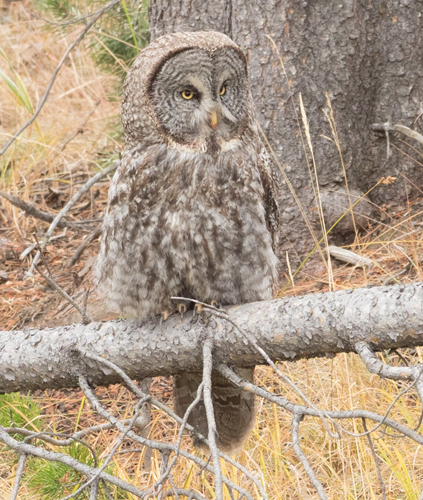
Cropped, I have a nice shot of the Great Gray Owl. Below was
the original, shot with the Olympus 300mm lens.
Pretty impressive detail!
.jpg)
We continued to the Grizzly, which was hidden but was last scene in a promising location. Although it was now nearly 3PM – what happened to lunch? – I decided that we’d wait and see what happened, as the possibility was great. About 45 minutes into our wait the bear started digging and grazing, and moved down through the valley for some excellent views. Since Mary and I were testing Olympus gear, and only had 300mm lenses, I decided to use my little Canon sureshot video, with 50X optical zoom (stretching it at 50!) and did video, which worked very, very well.
See the video.
By 5 we still hadn’t eaten, so we left the bear and started driving towards home and a picnic area, where we ate. At 5:30 we started for home, arriving at 7:30, shortly before a windy, rainy front arrived in Gardiner.
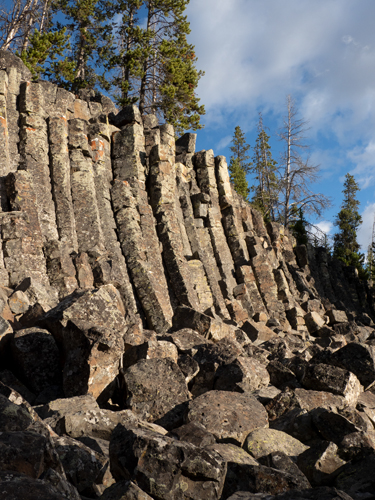
Day 3. Great weather today. We left at 6:25 again, driving back to Swan Lake Flats where we had a good sunrise shoot, with wonderful clouds and mountain color. No elk bugled, and no wolves or coyotes howled. After the shoot we headed to Sheep Eaters Cliff for breakfast and to shoot the basalt cliffs.
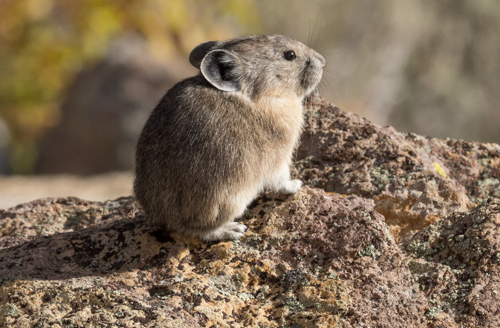
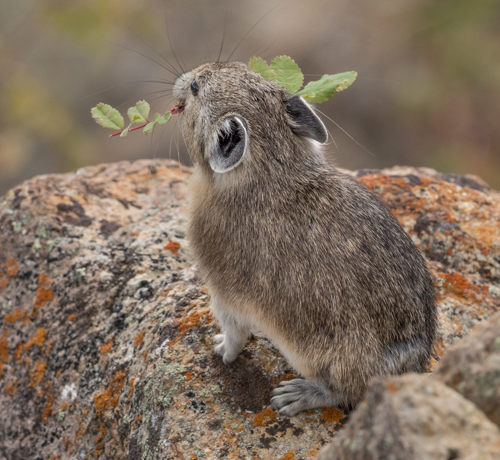
One of my favorite subjects, the talus-slope-loving American Pika.
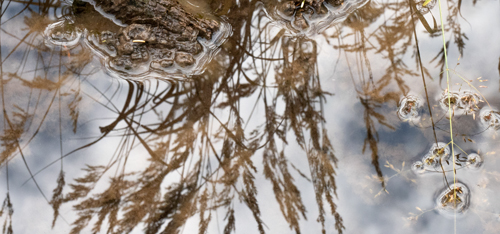
One of our assignments was reflections - here's an example.
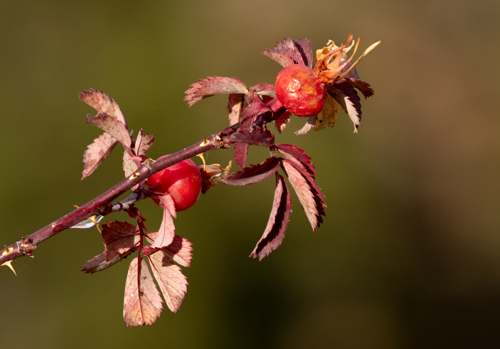
Another - macro - like this Rose Hip.
Next, as we drove back down towards Mammoth, we stopped for fairly good Pika shooting, with one very cooperative Pika. We continued on to Tower Junction, having breakfast at Yellowstone Picnic area before continuing through Little America and Lamar Valley. We had a few Pronghorn, but we always arrived a few minutes late, as Pronghorns crossed the road in front of us. Had we been earlier, we’d have had the Pronghorns as they approached the road – but that’s nature.
In Lamar Valley we stopped for a reported wolf sighting, but I put my scope on it and identified it as a Coyote. While watching, one of the other scope users shouted there was a grizzly. Well, that was a Badger, short-legged, longer tailed, that wandered around near the Coyote.
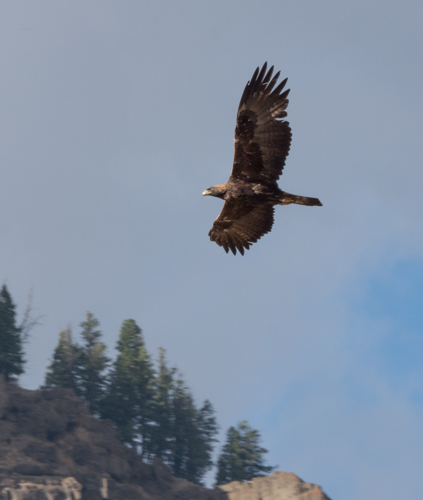
We drove on, and in Lamar had two Golden Eagles circling in front of us while we were photographing Bison. I screwed up, with my shutter speed too slow – and still too unfamiliar with my Olympus to make a quick adjustment. All but two shots were terribly blurred, at 1/250th.
We drove to the end of Lamar, turned back, and headed back towards home, beginning that journey at 4:30PM. At 6 we reached the gate, and just outside the park we had several Pronghorns – the best of the day, with bucks chasing does and often being quite close. Cold and wind accompanied the Pronghorn, and the last shoot of the day was a cold one.
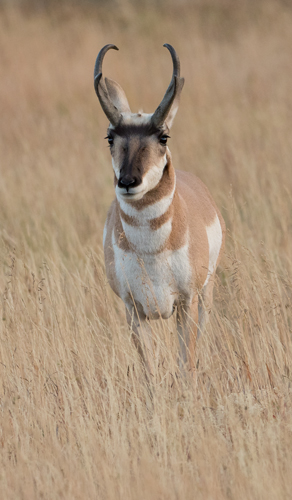
Day 4. The weather forecast for the next three days seemed awful, and we were worried whether we'd be able to reach Bozeman two days hence, to make our flights and to store some of our gear at a good friend's house. The morning was cold, dreary, and rainy, and our group had breakfast in our room, hoping that the weather might improve while we enjoyed a dry, warm meal. The weather did not cooperate, and to make the most of the morning we decided to do our slide shows of the participants' images that morning. When that was finished, I showed a new program on the Essentials of Wildlife Photography, a show I'd be giving in Texas the following weekend. That program generated a lot of questions and discussions, and made our rain-in morning a very productive one.
We had lunch in the room, too, but with the weather forecasted to clear we headed towards Tower Junction, stopping for landscapes while we looked for wildlife along the main road. Because of the bad weather the Elk that had clustered at Mammoth had moved downhill, and were now in a sage meadow below the campground. We had some nice shots of the Bull Elk in a natural setting.
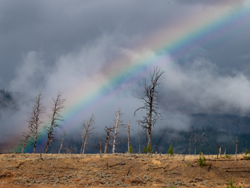 The afternoon was a somewhat short one, with landscapes, including a rainbow over an old fire-scarred landscape, and slow shutter speeds at Tower Creek, where we saw a dipper. The weather closed in again and we returned to the lodge as rain began.
The afternoon was a somewhat short one, with landscapes, including a rainbow over an old fire-scarred landscape, and slow shutter speeds at Tower Creek, where we saw a dipper. The weather closed in again and we returned to the lodge as rain began.
Although we're always looking for wildlife, Yellowstone offers so much more, and to make sure everyone has a broad portfolio that captures all of Yellowstone's beauty we provide a shooting list, covering everything from a 'dead tree' to a 'bison as icon.' Even though I shoot from this list every year I find I'm always shooting new images. Sometimes, getting a really powerful shot - like the 'Bison as Icon' - is a challenge, but having our list always keeps me motivated. Sorry to say, but I think too many photographers are focused solely on the big mammals and ignore the beauty that is all around them here.

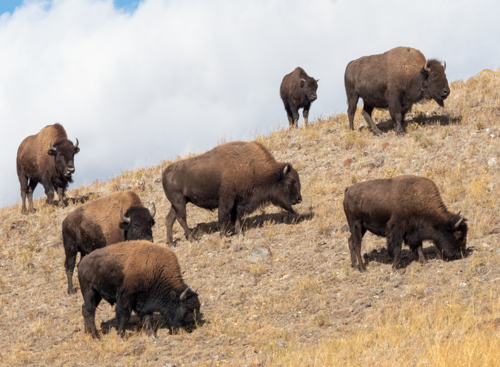
Two attempts at Bison as Icon
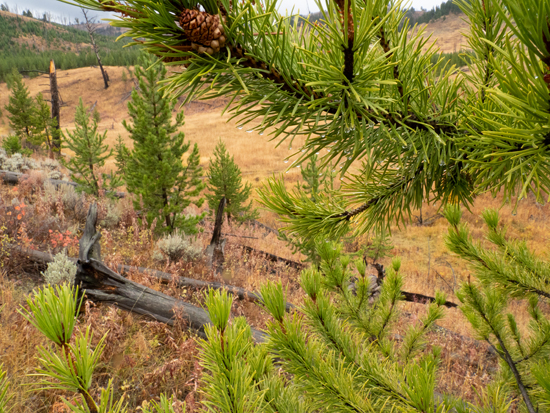
I hand-held this wide-angle scene, at 1/160th sec at f18, ISO 1000.
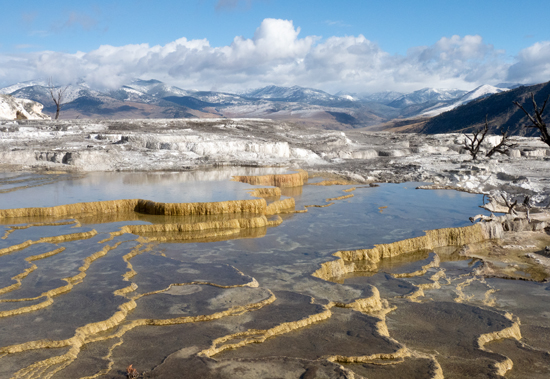
Mammoth Hot Springs
Day 5. Snow was forecasted overnight, and we awoke to snow-covered mountains and the very real threat of icy roads. We had planned on shooting closer to the lodge, looking for Pronghorn, and so we had breakfast in the room. Afterwards, not seeing Pronghorn, we continued to the Mammoth Terraces where we had a great shoot, with beautiful light, steamy scenes, and a pair of Killdeer that walked close, providing reflections in the travertine pools.
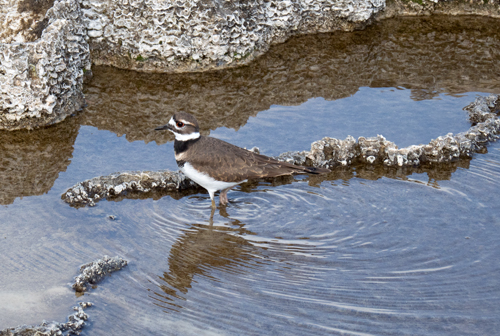
We had lunch at Lava Creek, where I unsuccessfully looked for Dippers (the nest they usually use was gone), and headed towards Tower. At Hell Roaring Creek, we had a real highlight - a flock of Blue Grouse (Dusky subspecies) that fed close to the road. Had one not been on the berm we'd have missed these well-camouflaged grouse, but once spotted, they performed. Several in the flock climbed on top a large fallen log to pose, before moving to the main road. There, we acted as crossing guards, blocking traffic so the birds could meander across safely.
 Grouse_18_050358.jpg)
One of the Blue Grouse that we found on our last day --
only the second time we've had the opportunity to photograph
this tame grouse in the fall.
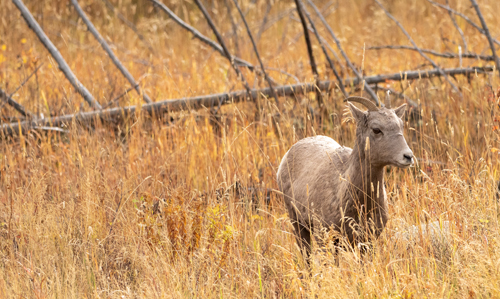
We continued to Tower, photographing Rose Hips and the Creek again, where we searched for Dippers. Along the way we had a ewe Bighorn Sheep, that cooperated by trotting to the road and crossing. At the Blacktail Lakes we had one of the nicest bull Elk we've seen outside the Mammoth area, lying down beside a bush. Since nothing was happening, we left, and at the end of the day encountered it again, now standing and grazing, when the photography was a bit more interesting.
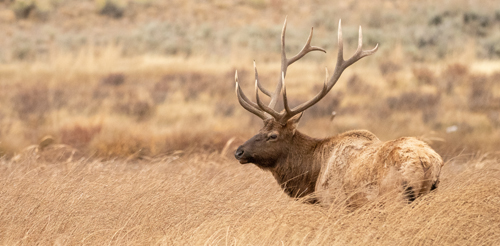
After Tower we started home, and those sitting on the right side of the vehicle saw a Black Bear, far down the slope, that had caused a real traffic jam. We reached the lodge at sunset, the air cold with a broken, brooding sky. In our room we reviewed the week's highlights and favorite shots, locations, and subjects, a wonderful recap for a productive week.
Day 6. With final goodbyes, our participants either drove to the Tetons or other locations, while Mary and I drove the remainder to the airport in Bozeman. The roads were clear and the weather fine for our trip home -- concluding the trip.
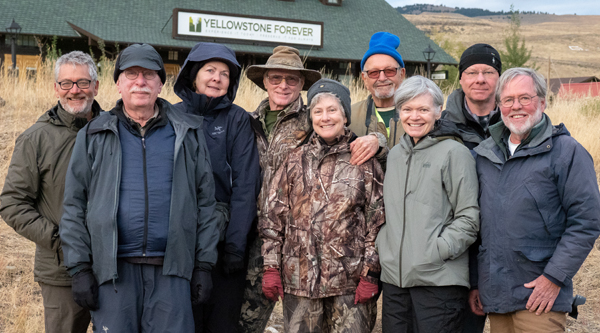
Our group - Mac, Dick, Roberta, Joe, Mary, Dave, Gywn, Ivoe, and Tom
Last Update: September 30, 2018
Check out our Camera-Lens Sale
Join us on Facebook at: Follow Hoot Hollow
Office Phone: (717) 543-6423
Or FAX us at: (717) 543-5342
Mary and Joe are proud to endorse the Photo Retailer that has
done the absolute most in supporting nature photography in all
its facets ---

Check out the Monthly Specials
from Hunt's
Check out these TPPA specials!
Yellowstone Fall Photo Tour
2018 Trip Report

We offer the finest in small group wildlife and nature photography tours,
workshops and safaris, both domestic and foreign.

Our schedule required a shorter tour this year, of only four days, but it was an extremely productive one. The first week of October offers the threat of winter, and we were worried that snow might influence the trip. Luck was with us and the bad weather held off, allowing us to get to the spots we wanted to visit.
Mary and I used Olympus Mirrorless Cameras for the first time, as part of a pro-loaner program Olympus was doing. We had two complete kits, which required me to spend an entire day reading the on-line manual to understand the camera. Like most manuals, I was confused at times, but once mastered, I found the camera easy to use and the menus very useful.
These Olympus Cameras -- OM-D E Mark II -have a great image stabilization system, and to test it both Mary and I rarely used a tripod. This was a first for me, as I always use a tripod, but to be fair, or accurate, to the IS claim, hand-holding was best. I was impressed, and even with macro shots I obtained usable shots at slow shutter speeds -- really challenging any image stabilization system.

Water droplets on fine grasses. The mass of 'bubbles' reminded me of a jellyfish in a freshwater lake I've seen in a film. This image, shot with a macro, was hand-held at 1/160th sec at f22, ISO 1600.
In shooting our landscapes, I did several scenes where I planned to do a HDR merge, via Photoshop, but I found that the dynamic range of the RAW capture allowed me to either tone down brights, or pull up blacks, to capture the scene with one shot. That really impressed me too.
I shot the Tower Creek scenes, below, using a tripod, as my shutter speeds ranged from 1/8th to 1/3rd of a second. I exposed for the whites -- controlling that exposure, but in doing so the rocks and trees were very underexposed. In the RAW converter I brought back the dark areas -- a great example of dynamic range. Below, I've included the original and the finished shots - impressive.


Tower Creek, at 1/3rd and 1/6th sec, f22 ISO 200.
In these exposures, if I exposed for the white water the surrounding rocks and trees where dark, and if I exposed for the rocks, the water was over-exposed.








Here's the RAW shots (Left) and the shot after RAW conversion -
the larger images, above, were similar. Pretty good dynamic range!
It is always fun to be doing a tour with photographers who have not been to an area before, and that was the case this year. A few of our participants had visited Yellowstone many years earlier, and for the others it was new. And, for us, most of our participants were new to us, and it was wonderful to make new friends.
Here's the day-to-day report:

Electric Peak from the pull-off at Swan Lake Flats. Sadly, the trail leading to the lake shore is now closed. I assume the trail was closed in the spring nesting season and the signs never removed, blocking one of the prettiest scenic spots for photographers. Tundra Swans were visible, and in the past were easily photographed, as the birds were unconcerned. Now ... that is lost!

I used the focus composite feature of the Olympus, that does stacking in the camera
for this macro shot.




Day 1. We met some of our participants in Bozeman, then drove to 100 miles to Gardiner where we met the rest of the group. After a group dinner at a local restaurant we had our orientation meeting and slide show, discussing our plans for the week and our subjects. We concluded early, giving everyone time to get ready for our first day of shooting.
Day 2. We left at 6:25, hoping to get a sunrise at Swan Lake Flats but the sky was overcast. Most distressing, Swan Lake Flats was closed, with a sign saying that the area was closed to protect the birds and wildlife. I’d assume that sign was erected in spring, during nesting, but was never taken down, and now this beautiful area for scenic photography is closed. Criminal!
We headed south, stopping at a new visitor site with a boardwalk that leads to a pretty thermal and springs. Afterwards, we continued to Norris for breakfast, where a herd of Bison joined us, moving about and requiring us to shift positions constantly to keep our distance and to be safe. Eventually they moved off, 1.5 hours later.


We drove on to Artist Point at the Grand Canyon for scenic, and while there Mary got a text that a Grizzly was spotted near Yellowstone lake. At the Pelican Flats area Mary spotted a Great Gray Owl, and we moved out across a broad field and marsh to look for the owl. Eventually we found it, and got decent photos, and attracted a huge crowd. When the masses arrived we left – hopefully leaving the owl in peace.




The Olympus has a 'pro capture' mode, where images are recorded when the shutter is pressed halfway, stopping when the shutter is fully pressed to capture action. This Great Gray Owl landed on the log, and I was using 'pro capture', but unfortunately the bird was facing away from me. Still, you can see how this works.

Cropped, I have a nice shot of the Great Gray Owl. Below was
the original, shot with the Olympus 300mm lens.
Pretty impressive detail!
.jpg)
We continued to the Grizzly, which was hidden but was last scene in a promising location. Although it was now nearly 3PM – what happened to lunch? – I decided that we’d wait and see what happened, as the possibility was great. About 45 minutes into our wait the bear started digging and grazing, and moved down through the valley for some excellent views. Since Mary and I were testing Olympus gear, and only had 300mm lenses, I decided to use my little Canon sureshot video, with 50X optical zoom (stretching it at 50!) and did video, which worked very, very well.
See the video.
By 5 we still hadn’t eaten, so we left the bear and started driving towards home and a picnic area, where we ate. At 5:30 we started for home, arriving at 7:30, shortly before a windy, rainy front arrived in Gardiner.

Day 3. Great weather today. We left at 6:25 again, driving back to Swan Lake Flats where we had a good sunrise shoot, with wonderful clouds and mountain color. No elk bugled, and no wolves or coyotes howled. After the shoot we headed to Sheep Eaters Cliff for breakfast and to shoot the basalt cliffs.


One of my favorite subjects, the talus-slope-loving American Pika.

One of our assignments was reflections - here's an example.

Another - macro - like this Rose Hip.
Next, as we drove back down towards Mammoth, we stopped for fairly good Pika shooting, with one very cooperative Pika. We continued on to Tower Junction, having breakfast at Yellowstone Picnic area before continuing through Little America and Lamar Valley. We had a few Pronghorn, but we always arrived a few minutes late, as Pronghorns crossed the road in front of us. Had we been earlier, we’d have had the Pronghorns as they approached the road – but that’s nature.
In Lamar Valley we stopped for a reported wolf sighting, but I put my scope on it and identified it as a Coyote. While watching, one of the other scope users shouted there was a grizzly. Well, that was a Badger, short-legged, longer tailed, that wandered around near the Coyote.

We drove on, and in Lamar had two Golden Eagles circling in front of us while we were photographing Bison. I screwed up, with my shutter speed too slow – and still too unfamiliar with my Olympus to make a quick adjustment. All but two shots were terribly blurred, at 1/250th.
We drove to the end of Lamar, turned back, and headed back towards home, beginning that journey at 4:30PM. At 6 we reached the gate, and just outside the park we had several Pronghorns – the best of the day, with bucks chasing does and often being quite close. Cold and wind accompanied the Pronghorn, and the last shoot of the day was a cold one.

Day 4. The weather forecast for the next three days seemed awful, and we were worried whether we'd be able to reach Bozeman two days hence, to make our flights and to store some of our gear at a good friend's house. The morning was cold, dreary, and rainy, and our group had breakfast in our room, hoping that the weather might improve while we enjoyed a dry, warm meal. The weather did not cooperate, and to make the most of the morning we decided to do our slide shows of the participants' images that morning. When that was finished, I showed a new program on the Essentials of Wildlife Photography, a show I'd be giving in Texas the following weekend. That program generated a lot of questions and discussions, and made our rain-in morning a very productive one.
We had lunch in the room, too, but with the weather forecasted to clear we headed towards Tower Junction, stopping for landscapes while we looked for wildlife along the main road. Because of the bad weather the Elk that had clustered at Mammoth had moved downhill, and were now in a sage meadow below the campground. We had some nice shots of the Bull Elk in a natural setting.
 The afternoon was a somewhat short one, with landscapes, including a rainbow over an old fire-scarred landscape, and slow shutter speeds at Tower Creek, where we saw a dipper. The weather closed in again and we returned to the lodge as rain began.
The afternoon was a somewhat short one, with landscapes, including a rainbow over an old fire-scarred landscape, and slow shutter speeds at Tower Creek, where we saw a dipper. The weather closed in again and we returned to the lodge as rain began.
Although we're always looking for wildlife, Yellowstone offers so much more, and to make sure everyone has a broad portfolio that captures all of Yellowstone's beauty we provide a shooting list, covering everything from a 'dead tree' to a 'bison as icon.' Even though I shoot from this list every year I find I'm always shooting new images. Sometimes, getting a really powerful shot - like the 'Bison as Icon' - is a challenge, but having our list always keeps me motivated. Sorry to say, but I think too many photographers are focused solely on the big mammals and ignore the beauty that is all around them here.


Two attempts at Bison as Icon

I hand-held this wide-angle scene, at 1/160th sec at f18, ISO 1000.

Mammoth Hot Springs
Day 5. Snow was forecasted overnight, and we awoke to snow-covered mountains and the very real threat of icy roads. We had planned on shooting closer to the lodge, looking for Pronghorn, and so we had breakfast in the room. Afterwards, not seeing Pronghorn, we continued to the Mammoth Terraces where we had a great shoot, with beautiful light, steamy scenes, and a pair of Killdeer that walked close, providing reflections in the travertine pools.

We had lunch at Lava Creek, where I unsuccessfully looked for Dippers (the nest they usually use was gone), and headed towards Tower. At Hell Roaring Creek, we had a real highlight - a flock of Blue Grouse (Dusky subspecies) that fed close to the road. Had one not been on the berm we'd have missed these well-camouflaged grouse, but once spotted, they performed. Several in the flock climbed on top a large fallen log to pose, before moving to the main road. There, we acted as crossing guards, blocking traffic so the birds could meander across safely.
 Grouse_18_050358.jpg)
One of the Blue Grouse that we found on our last day --
only the second time we've had the opportunity to photograph
this tame grouse in the fall.

We continued to Tower, photographing Rose Hips and the Creek again, where we searched for Dippers. Along the way we had a ewe Bighorn Sheep, that cooperated by trotting to the road and crossing. At the Blacktail Lakes we had one of the nicest bull Elk we've seen outside the Mammoth area, lying down beside a bush. Since nothing was happening, we left, and at the end of the day encountered it again, now standing and grazing, when the photography was a bit more interesting.

After Tower we started home, and those sitting on the right side of the vehicle saw a Black Bear, far down the slope, that had caused a real traffic jam. We reached the lodge at sunset, the air cold with a broken, brooding sky. In our room we reviewed the week's highlights and favorite shots, locations, and subjects, a wonderful recap for a productive week.
Day 6. With final goodbyes, our participants either drove to the Tetons or other locations, while Mary and I drove the remainder to the airport in Bozeman. The roads were clear and the weather fine for our trip home -- concluding the trip.

Our group - Mac, Dick, Roberta, Joe, Mary, Dave, Gywn, Ivoe, and Tom
Last Update: September 30, 2018
Check out our Camera-Lens Sale
Join us on Facebook at: Follow Hoot Hollow
Office Phone: (717) 543-6423
Or FAX us at: (717) 543-5342
Mary and Joe are proud to endorse the Photo Retailer that has
done the absolute most in supporting nature photography in all
its facets ---

Check out the Monthly Specials
from Hunt's
Check out these TPPA specials!
Yellowstone Fall Photo Tour
2018 Trip Report

We offer the finest in small group wildlife and nature photography tours,
workshops and safaris, both domestic and foreign.

Our schedule required a shorter tour this year, of only four days, but it was an extremely productive one. The first week of October offers the threat of winter, and we were worried that snow might influence the trip. Luck was with us and the bad weather held off, allowing us to get to the spots we wanted to visit.
Mary and I used Olympus Mirrorless Cameras for the first time, as part of a pro-loaner program Olympus was doing. We had two complete kits, which required me to spend an entire day reading the on-line manual to understand the camera. Like most manuals, I was confused at times, but once mastered, I found the camera easy to use and the menus very useful.
These Olympus Cameras -- OM-D E Mark II -have a great image stabilization system, and to test it both Mary and I rarely used a tripod. This was a first for me, as I always use a tripod, but to be fair, or accurate, to the IS claim, hand-holding was best. I was impressed, and even with macro shots I obtained usable shots at slow shutter speeds -- really challenging any image stabilization system.

Water droplets on fine grasses. The mass of 'bubbles' reminded me of a jellyfish in a freshwater lake I've seen in a film. This image, shot with a macro, was hand-held at 1/160th sec at f22, ISO 1600.
In shooting our landscapes, I did several scenes where I planned to do a HDR merge, via Photoshop, but I found that the dynamic range of the RAW capture allowed me to either tone down brights, or pull up blacks, to capture the scene with one shot. That really impressed me too.
I shot the Tower Creek scenes, below, using a tripod, as my shutter speeds ranged from 1/8th to 1/3rd of a second. I exposed for the whites -- controlling that exposure, but in doing so the rocks and trees were very underexposed. In the RAW converter I brought back the dark areas -- a great example of dynamic range. Below, I've included the original and the finished shots - impressive.


Tower Creek, at 1/3rd and 1/6th sec, f22 ISO 200.
In these exposures, if I exposed for the white water the surrounding rocks and trees where dark, and if I exposed for the rocks, the water was over-exposed.








Here's the RAW shots (Left) and the shot after RAW conversion -
the larger images, above, were similar. Pretty good dynamic range!
It is always fun to be doing a tour with photographers who have not been to an area before, and that was the case this year. A few of our participants had visited Yellowstone many years earlier, and for the others it was new. And, for us, most of our participants were new to us, and it was wonderful to make new friends.
Here's the day-to-day report:

Electric Peak from the pull-off at Swan Lake Flats. Sadly, the trail leading to the lake shore is now closed. I assume the trail was closed in the spring nesting season and the signs never removed, blocking one of the prettiest scenic spots for photographers. Tundra Swans were visible, and in the past were easily photographed, as the birds were unconcerned. Now ... that is lost!

I used the focus composite feature of the Olympus, that does stacking in the camera
for this macro shot.




Day 1. We met some of our participants in Bozeman, then drove to 100 miles to Gardiner where we met the rest of the group. After a group dinner at a local restaurant we had our orientation meeting and slide show, discussing our plans for the week and our subjects. We concluded early, giving everyone time to get ready for our first day of shooting.
Day 2. We left at 6:25, hoping to get a sunrise at Swan Lake Flats but the sky was overcast. Most distressing, Swan Lake Flats was closed, with a sign saying that the area was closed to protect the birds and wildlife. I’d assume that sign was erected in spring, during nesting, but was never taken down, and now this beautiful area for scenic photography is closed. Criminal!
We headed south, stopping at a new visitor site with a boardwalk that leads to a pretty thermal and springs. Afterwards, we continued to Norris for breakfast, where a herd of Bison joined us, moving about and requiring us to shift positions constantly to keep our distance and to be safe. Eventually they moved off, 1.5 hours later.


We drove on to Artist Point at the Grand Canyon for scenic, and while there Mary got a text that a Grizzly was spotted near Yellowstone lake. At the Pelican Flats area Mary spotted a Great Gray Owl, and we moved out across a broad field and marsh to look for the owl. Eventually we found it, and got decent photos, and attracted a huge crowd. When the masses arrived we left – hopefully leaving the owl in peace.




The Olympus has a 'pro capture' mode, where images are recorded when the shutter is pressed halfway, stopping when the shutter is fully pressed to capture action. This Great Gray Owl landed on the log, and I was using 'pro capture', but unfortunately the bird was facing away from me. Still, you can see how this works.

Cropped, I have a nice shot of the Great Gray Owl. Below was
the original, shot with the Olympus 300mm lens.
Pretty impressive detail!
.jpg)
We continued to the Grizzly, which was hidden but was last scene in a promising location. Although it was now nearly 3PM – what happened to lunch? – I decided that we’d wait and see what happened, as the possibility was great. About 45 minutes into our wait the bear started digging and grazing, and moved down through the valley for some excellent views. Since Mary and I were testing Olympus gear, and only had 300mm lenses, I decided to use my little Canon sureshot video, with 50X optical zoom (stretching it at 50!) and did video, which worked very, very well.
See the video.
By 5 we still hadn’t eaten, so we left the bear and started driving towards home and a picnic area, where we ate. At 5:30 we started for home, arriving at 7:30, shortly before a windy, rainy front arrived in Gardiner.

Day 3. Great weather today. We left at 6:25 again, driving back to Swan Lake Flats where we had a good sunrise shoot, with wonderful clouds and mountain color. No elk bugled, and no wolves or coyotes howled. After the shoot we headed to Sheep Eaters Cliff for breakfast and to shoot the basalt cliffs.


One of my favorite subjects, the talus-slope-loving American Pika.

One of our assignments was reflections - here's an example.

Another - macro - like this Rose Hip.
Next, as we drove back down towards Mammoth, we stopped for fairly good Pika shooting, with one very cooperative Pika. We continued on to Tower Junction, having breakfast at Yellowstone Picnic area before continuing through Little America and Lamar Valley. We had a few Pronghorn, but we always arrived a few minutes late, as Pronghorns crossed the road in front of us. Had we been earlier, we’d have had the Pronghorns as they approached the road – but that’s nature.
In Lamar Valley we stopped for a reported wolf sighting, but I put my scope on it and identified it as a Coyote. While watching, one of the other scope users shouted there was a grizzly. Well, that was a Badger, short-legged, longer tailed, that wandered around near the Coyote.

We drove on, and in Lamar had two Golden Eagles circling in front of us while we were photographing Bison. I screwed up, with my shutter speed too slow – and still too unfamiliar with my Olympus to make a quick adjustment. All but two shots were terribly blurred, at 1/250th.
We drove to the end of Lamar, turned back, and headed back towards home, beginning that journey at 4:30PM. At 6 we reached the gate, and just outside the park we had several Pronghorns – the best of the day, with bucks chasing does and often being quite close. Cold and wind accompanied the Pronghorn, and the last shoot of the day was a cold one.

Day 4. The weather forecast for the next three days seemed awful, and we were worried whether we'd be able to reach Bozeman two days hence, to make our flights and to store some of our gear at a good friend's house. The morning was cold, dreary, and rainy, and our group had breakfast in our room, hoping that the weather might improve while we enjoyed a dry, warm meal. The weather did not cooperate, and to make the most of the morning we decided to do our slide shows of the participants' images that morning. When that was finished, I showed a new program on the Essentials of Wildlife Photography, a show I'd be giving in Texas the following weekend. That program generated a lot of questions and discussions, and made our rain-in morning a very productive one.
We had lunch in the room, too, but with the weather forecasted to clear we headed towards Tower Junction, stopping for landscapes while we looked for wildlife along the main road. Because of the bad weather the Elk that had clustered at Mammoth had moved downhill, and were now in a sage meadow below the campground. We had some nice shots of the Bull Elk in a natural setting.
 The afternoon was a somewhat short one, with landscapes, including a rainbow over an old fire-scarred landscape, and slow shutter speeds at Tower Creek, where we saw a dipper. The weather closed in again and we returned to the lodge as rain began.
The afternoon was a somewhat short one, with landscapes, including a rainbow over an old fire-scarred landscape, and slow shutter speeds at Tower Creek, where we saw a dipper. The weather closed in again and we returned to the lodge as rain began.
Although we're always looking for wildlife, Yellowstone offers so much more, and to make sure everyone has a broad portfolio that captures all of Yellowstone's beauty we provide a shooting list, covering everything from a 'dead tree' to a 'bison as icon.' Even though I shoot from this list every year I find I'm always shooting new images. Sometimes, getting a really powerful shot - like the 'Bison as Icon' - is a challenge, but having our list always keeps me motivated. Sorry to say, but I think too many photographers are focused solely on the big mammals and ignore the beauty that is all around them here.


Two attempts at Bison as Icon

I hand-held this wide-angle scene, at 1/160th sec at f18, ISO 1000.

Mammoth Hot Springs
Day 5. Snow was forecasted overnight, and we awoke to snow-covered mountains and the very real threat of icy roads. We had planned on shooting closer to the lodge, looking for Pronghorn, and so we had breakfast in the room. Afterwards, not seeing Pronghorn, we continued to the Mammoth Terraces where we had a great shoot, with beautiful light, steamy scenes, and a pair of Killdeer that walked close, providing reflections in the travertine pools.

We had lunch at Lava Creek, where I unsuccessfully looked for Dippers (the nest they usually use was gone), and headed towards Tower. At Hell Roaring Creek, we had a real highlight - a flock of Blue Grouse (Dusky subspecies) that fed close to the road. Had one not been on the berm we'd have missed these well-camouflaged grouse, but once spotted, they performed. Several in the flock climbed on top a large fallen log to pose, before moving to the main road. There, we acted as crossing guards, blocking traffic so the birds could meander across safely.
 Grouse_18_050358.jpg)
One of the Blue Grouse that we found on our last day --
only the second time we've had the opportunity to photograph
this tame grouse in the fall.

We continued to Tower, photographing Rose Hips and the Creek again, where we searched for Dippers. Along the way we had a ewe Bighorn Sheep, that cooperated by trotting to the road and crossing. At the Blacktail Lakes we had one of the nicest bull Elk we've seen outside the Mammoth area, lying down beside a bush. Since nothing was happening, we left, and at the end of the day encountered it again, now standing and grazing, when the photography was a bit more interesting.

After Tower we started home, and those sitting on the right side of the vehicle saw a Black Bear, far down the slope, that had caused a real traffic jam. We reached the lodge at sunset, the air cold with a broken, brooding sky. In our room we reviewed the week's highlights and favorite shots, locations, and subjects, a wonderful recap for a productive week.
Day 6. With final goodbyes, our participants either drove to the Tetons or other locations, while Mary and I drove the remainder to the airport in Bozeman. The roads were clear and the weather fine for our trip home -- concluding the trip.

Our group - Mac, Dick, Roberta, Joe, Mary, Dave, Gywn, Ivoe, and Tom
Last Update: September 30, 2018
Check out our Camera-Lens Sale
Join us on Facebook at: Follow Hoot Hollow
Office Phone: (717) 543-6423
Or FAX us at: (717) 543-5342
Mary and Joe are proud to endorse the Photo Retailer that has
done the absolute most in supporting nature photography in all
its facets ---

Check out the Monthly Specials
from Hunt's
Check out these TPPA specials!
Yellowstone Fall Photo Tour
2018 Trip Report

We offer the finest in small group wildlife and nature photography tours,
workshops and safaris, both domestic and foreign.

Our schedule required a shorter tour this year, of only four days, but it was an extremely productive one. The first week of October offers the threat of winter, and we were worried that snow might influence the trip. Luck was with us and the bad weather held off, allowing us to get to the spots we wanted to visit.
Mary and I used Olympus Mirrorless Cameras for the first time, as part of a pro-loaner program Olympus was doing. We had two complete kits, which required me to spend an entire day reading the on-line manual to understand the camera. Like most manuals, I was confused at times, but once mastered, I found the camera easy to use and the menus very useful.
These Olympus Cameras -- OM-D E Mark II -have a great image stabilization system, and to test it both Mary and I rarely used a tripod. This was a first for me, as I always use a tripod, but to be fair, or accurate, to the IS claim, hand-holding was best. I was impressed, and even with macro shots I obtained usable shots at slow shutter speeds -- really challenging any image stabilization system.

Water droplets on fine grasses. The mass of 'bubbles' reminded me of a jellyfish in a freshwater lake I've seen in a film. This image, shot with a macro, was hand-held at 1/160th sec at f22, ISO 1600.
In shooting our landscapes, I did several scenes where I planned to do a HDR merge, via Photoshop, but I found that the dynamic range of the RAW capture allowed me to either tone down brights, or pull up blacks, to capture the scene with one shot. That really impressed me too.
I shot the Tower Creek scenes, below, using a tripod, as my shutter speeds ranged from 1/8th to 1/3rd of a second. I exposed for the whites -- controlling that exposure, but in doing so the rocks and trees were very underexposed. In the RAW converter I brought back the dark areas -- a great example of dynamic range. Below, I've included the original and the finished shots - impressive.


Tower Creek, at 1/3rd and 1/6th sec, f22 ISO 200.
In these exposures, if I exposed for the white water the surrounding rocks and trees where dark, and if I exposed for the rocks, the water was over-exposed.








Here's the RAW shots (Left) and the shot after RAW conversion -
the larger images, above, were similar. Pretty good dynamic range!
It is always fun to be doing a tour with photographers who have not been to an area before, and that was the case this year. A few of our participants had visited Yellowstone many years earlier, and for the others it was new. And, for us, most of our participants were new to us, and it was wonderful to make new friends.
Here's the day-to-day report:

Electric Peak from the pull-off at Swan Lake Flats. Sadly, the trail leading to the lake shore is now closed. I assume the trail was closed in the spring nesting season and the signs never removed, blocking one of the prettiest scenic spots for photographers. Tundra Swans were visible, and in the past were easily photographed, as the birds were unconcerned. Now ... that is lost!

I used the focus composite feature of the Olympus, that does stacking in the camera
for this macro shot.




Day 1. We met some of our participants in Bozeman, then drove to 100 miles to Gardiner where we met the rest of the group. After a group dinner at a local restaurant we had our orientation meeting and slide show, discussing our plans for the week and our subjects. We concluded early, giving everyone time to get ready for our first day of shooting.
Day 2. We left at 6:25, hoping to get a sunrise at Swan Lake Flats but the sky was overcast. Most distressing, Swan Lake Flats was closed, with a sign saying that the area was closed to protect the birds and wildlife. I’d assume that sign was erected in spring, during nesting, but was never taken down, and now this beautiful area for scenic photography is closed. Criminal!
We headed south, stopping at a new visitor site with a boardwalk that leads to a pretty thermal and springs. Afterwards, we continued to Norris for breakfast, where a herd of Bison joined us, moving about and requiring us to shift positions constantly to keep our distance and to be safe. Eventually they moved off, 1.5 hours later.


We drove on to Artist Point at the Grand Canyon for scenic, and while there Mary got a text that a Grizzly was spotted near Yellowstone lake. At the Pelican Flats area Mary spotted a Great Gray Owl, and we moved out across a broad field and marsh to look for the owl. Eventually we found it, and got decent photos, and attracted a huge crowd. When the masses arrived we left – hopefully leaving the owl in peace.




The Olympus has a 'pro capture' mode, where images are recorded when the shutter is pressed halfway, stopping when the shutter is fully pressed to capture action. This Great Gray Owl landed on the log, and I was using 'pro capture', but unfortunately the bird was facing away from me. Still, you can see how this works.

Cropped, I have a nice shot of the Great Gray Owl. Below was
the original, shot with the Olympus 300mm lens.
Pretty impressive detail!
.jpg)
We continued to the Grizzly, which was hidden but was last scene in a promising location. Although it was now nearly 3PM – what happened to lunch? – I decided that we’d wait and see what happened, as the possibility was great. About 45 minutes into our wait the bear started digging and grazing, and moved down through the valley for some excellent views. Since Mary and I were testing Olympus gear, and only had 300mm lenses, I decided to use my little Canon sureshot video, with 50X optical zoom (stretching it at 50!) and did video, which worked very, very well.
See the video.
By 5 we still hadn’t eaten, so we left the bear and started driving towards home and a picnic area, where we ate. At 5:30 we started for home, arriving at 7:30, shortly before a windy, rainy front arrived in Gardiner.

Day 3. Great weather today. We left at 6:25 again, driving back to Swan Lake Flats where we had a good sunrise shoot, with wonderful clouds and mountain color. No elk bugled, and no wolves or coyotes howled. After the shoot we headed to Sheep Eaters Cliff for breakfast and to shoot the basalt cliffs.


One of my favorite subjects, the talus-slope-loving American Pika.

One of our assignments was reflections - here's an example.

Another - macro - like this Rose Hip.
Next, as we drove back down towards Mammoth, we stopped for fairly good Pika shooting, with one very cooperative Pika. We continued on to Tower Junction, having breakfast at Yellowstone Picnic area before continuing through Little America and Lamar Valley. We had a few Pronghorn, but we always arrived a few minutes late, as Pronghorns crossed the road in front of us. Had we been earlier, we’d have had the Pronghorns as they approached the road – but that’s nature.
In Lamar Valley we stopped for a reported wolf sighting, but I put my scope on it and identified it as a Coyote. While watching, one of the other scope users shouted there was a grizzly. Well, that was a Badger, short-legged, longer tailed, that wandered around near the Coyote.

We drove on, and in Lamar had two Golden Eagles circling in front of us while we were photographing Bison. I screwed up, with my shutter speed too slow – and still too unfamiliar with my Olympus to make a quick adjustment. All but two shots were terribly blurred, at 1/250th.
We drove to the end of Lamar, turned back, and headed back towards home, beginning that journey at 4:30PM. At 6 we reached the gate, and just outside the park we had several Pronghorns – the best of the day, with bucks chasing does and often being quite close. Cold and wind accompanied the Pronghorn, and the last shoot of the day was a cold one.

Day 4. The weather forecast for the next three days seemed awful, and we were worried whether we'd be able to reach Bozeman two days hence, to make our flights and to store some of our gear at a good friend's house. The morning was cold, dreary, and rainy, and our group had breakfast in our room, hoping that the weather might improve while we enjoyed a dry, warm meal. The weather did not cooperate, and to make the most of the morning we decided to do our slide shows of the participants' images that morning. When that was finished, I showed a new program on the Essentials of Wildlife Photography, a show I'd be giving in Texas the following weekend. That program generated a lot of questions and discussions, and made our rain-in morning a very productive one.
We had lunch in the room, too, but with the weather forecasted to clear we headed towards Tower Junction, stopping for landscapes while we looked for wildlife along the main road. Because of the bad weather the Elk that had clustered at Mammoth had moved downhill, and were now in a sage meadow below the campground. We had some nice shots of the Bull Elk in a natural setting.
 The afternoon was a somewhat short one, with landscapes, including a rainbow over an old fire-scarred landscape, and slow shutter speeds at Tower Creek, where we saw a dipper. The weather closed in again and we returned to the lodge as rain began.
The afternoon was a somewhat short one, with landscapes, including a rainbow over an old fire-scarred landscape, and slow shutter speeds at Tower Creek, where we saw a dipper. The weather closed in again and we returned to the lodge as rain began.
Although we're always looking for wildlife, Yellowstone offers so much more, and to make sure everyone has a broad portfolio that captures all of Yellowstone's beauty we provide a shooting list, covering everything from a 'dead tree' to a 'bison as icon.' Even though I shoot from this list every year I find I'm always shooting new images. Sometimes, getting a really powerful shot - like the 'Bison as Icon' - is a challenge, but having our list always keeps me motivated. Sorry to say, but I think too many photographers are focused solely on the big mammals and ignore the beauty that is all around them here.


Two attempts at Bison as Icon

I hand-held this wide-angle scene, at 1/160th sec at f18, ISO 1000.

Mammoth Hot Springs
Day 5. Snow was forecasted overnight, and we awoke to snow-covered mountains and the very real threat of icy roads. We had planned on shooting closer to the lodge, looking for Pronghorn, and so we had breakfast in the room. Afterwards, not seeing Pronghorn, we continued to the Mammoth Terraces where we had a great shoot, with beautiful light, steamy scenes, and a pair of Killdeer that walked close, providing reflections in the travertine pools.

We had lunch at Lava Creek, where I unsuccessfully looked for Dippers (the nest they usually use was gone), and headed towards Tower. At Hell Roaring Creek, we had a real highlight - a flock of Blue Grouse (Dusky subspecies) that fed close to the road. Had one not been on the berm we'd have missed these well-camouflaged grouse, but once spotted, they performed. Several in the flock climbed on top a large fallen log to pose, before moving to the main road. There, we acted as crossing guards, blocking traffic so the birds could meander across safely.
 Grouse_18_050358.jpg)
One of the Blue Grouse that we found on our last day --
only the second time we've had the opportunity to photograph
this tame grouse in the fall.

We continued to Tower, photographing Rose Hips and the Creek again, where we searched for Dippers. Along the way we had a ewe Bighorn Sheep, that cooperated by trotting to the road and crossing. At the Blacktail Lakes we had one of the nicest bull Elk we've seen outside the Mammoth area, lying down beside a bush. Since nothing was happening, we left, and at the end of the day encountered it again, now standing and grazing, when the photography was a bit more interesting.

After Tower we started home, and those sitting on the right side of the vehicle saw a Black Bear, far down the slope, that had caused a real traffic jam. We reached the lodge at sunset, the air cold with a broken, brooding sky. In our room we reviewed the week's highlights and favorite shots, locations, and subjects, a wonderful recap for a productive week.
Day 6. With final goodbyes, our participants either drove to the Tetons or other locations, while Mary and I drove the remainder to the airport in Bozeman. The roads were clear and the weather fine for our trip home -- concluding the trip.

Our group - Mac, Dick, Roberta, Joe, Mary, Dave, Gywn, Ivoe, and Tom
Last Update: September 30, 2018
Check out our Camera-Lens Sale
Join us on Facebook at: Follow Hoot Hollow
Office Phone: (717) 543-6423
Or FAX us at: (717) 543-5342
Mary and Joe are proud to endorse the Photo Retailer that has
done the absolute most in supporting nature photography in all
its facets ---

Check out the Monthly Specials
from Hunt's
Check out these TPPA specials!
Yellowstone Fall Photo Tour
2018 Trip Report
We offer the finest in small group wildlife and nature photography tours,
workshops and safaris, both domestic and foreign.

Our schedule required a shorter tour this year, of only four days, but it was an extremely productive one. The first week of October offers the threat of winter, and we were worried that snow might influence the trip. Luck was with us and the bad weather held off, allowing us to get to the spots we wanted to visit.
Mary and I used Olympus Mirrorless Cameras for the first time, as part of a pro-loaner program Olympus was doing. We had two complete kits, which required me to spend an entire day reading the on-line manual to understand the camera. Like most manuals, I was confused at times, but once mastered, I found the camera easy to use and the menus very useful.
These Olympus Cameras -- OM-D E Mark II -have a great image stabilization system, and to test it both Mary and I rarely used a tripod. This was a first for me, as I always use a tripod, but to be fair, or accurate, to the IS claim, hand-holding was best. I was impressed, and even with macro shots I obtained usable shots at slow shutter speeds -- really challenging any image stabilization system.

Water droplets on fine grasses. The mass of 'bubbles' reminded me of a jellyfish in a freshwater lake I've seen in a film. This image, shot with a macro, was hand-held at 1/160th sec at f22, ISO 1600.
In shooting our landscapes, I did several scenes where I planned to do a HDR merge, via Photoshop, but I found that the dynamic range of the RAW capture allowed me to either tone down brights, or pull up blacks, to capture the scene with one shot. That really impressed me too.
I shot the Tower Creek scenes, below, using a tripod, as my shutter speeds ranged from 1/8th to 1/3rd of a second. I exposed for the whites -- controlling that exposure, but in doing so the rocks and trees were very underexposed. In the RAW converter I brought back the dark areas -- a great example of dynamic range. Below, I've included the original and the finished shots - impressive.


Tower Creek, at 1/3rd and 1/6th sec, f22 ISO 200.
In these exposures, if I exposed for the white water the surrounding rocks and trees where dark, and if I exposed for the rocks, the water was over-exposed.








Here's the RAW shots (Left) and the shot after RAW conversion -
the larger images, above, were similar. Pretty good dynamic range!
It is always fun to be doing a tour with photographers who have not been to an area before, and that was the case this year. A few of our participants had visited Yellowstone many years earlier, and for the others it was new. And, for us, most of our participants were new to us, and it was wonderful to make new friends.
Here's the day-to-day report:

Electric Peak from the pull-off at Swan Lake Flats. Sadly, the trail leading to the lake shore is now closed. I assume the trail was closed in the spring nesting season and the signs never removed, blocking one of the prettiest scenic spots for photographers. Tundra Swans were visible, and in the past were easily photographed, as the birds were unconcerned. Now ... that is lost!

I used the focus composite feature of the Olympus, that does stacking in the camera
for this macro shot.




Day 1. We met some of our participants in Bozeman, then drove to 100 miles to Gardiner where we met the rest of the group. After a group dinner at a local restaurant we had our orientation meeting and slide show, discussing our plans for the week and our subjects. We concluded early, giving everyone time to get ready for our first day of shooting.
Day 2. We left at 6:25, hoping to get a sunrise at Swan Lake Flats but the sky was overcast. Most distressing, Swan Lake Flats was closed, with a sign saying that the area was closed to protect the birds and wildlife. I’d assume that sign was erected in spring, during nesting, but was never taken down, and now this beautiful area for scenic photography is closed. Criminal!
We headed south, stopping at a new visitor site with a boardwalk that leads to a pretty thermal and springs. Afterwards, we continued to Norris for breakfast, where a herd of Bison joined us, moving about and requiring us to shift positions constantly to keep our distance and to be safe. Eventually they moved off, 1.5 hours later.


We drove on to Artist Point at the Grand Canyon for scenic, and while there Mary got a text that a Grizzly was spotted near Yellowstone lake. At the Pelican Flats area Mary spotted a Great Gray Owl, and we moved out across a broad field and marsh to look for the owl. Eventually we found it, and got decent photos, and attracted a huge crowd. When the masses arrived we left – hopefully leaving the owl in peace.




The Olympus has a 'pro capture' mode, where images are recorded when the shutter is pressed halfway, stopping when the shutter is fully pressed to capture action. This Great Gray Owl landed on the log, and I was using 'pro capture', but unfortunately the bird was facing away from me. Still, you can see how this works.

Cropped, I have a nice shot of the Great Gray Owl. Below was
the original, shot with the Olympus 300mm lens.
Pretty impressive detail!
.jpg)
We continued to the Grizzly, which was hidden but was last scene in a promising location. Although it was now nearly 3PM – what happened to lunch? – I decided that we’d wait and see what happened, as the possibility was great. About 45 minutes into our wait the bear started digging and grazing, and moved down through the valley for some excellent views. Since Mary and I were testing Olympus gear, and only had 300mm lenses, I decided to use my little Canon sureshot video, with 50X optical zoom (stretching it at 50!) and did video, which worked very, very well.
See the video.
By 5 we still hadn’t eaten, so we left the bear and started driving towards home and a picnic area, where we ate. At 5:30 we started for home, arriving at 7:30, shortly before a windy, rainy front arrived in Gardiner.

Day 3. Great weather today. We left at 6:25 again, driving back to Swan Lake Flats where we had a good sunrise shoot, with wonderful clouds and mountain color. No elk bugled, and no wolves or coyotes howled. After the shoot we headed to Sheep Eaters Cliff for breakfast and to shoot the basalt cliffs.


One of my favorite subjects, the talus-slope-loving American Pika.

One of our assignments was reflections - here's an example.

Another - macro - like this Rose Hip.
Next, as we drove back down towards Mammoth, we stopped for fairly good Pika shooting, with one very cooperative Pika. We continued on to Tower Junction, having breakfast at Yellowstone Picnic area before continuing through Little America and Lamar Valley. We had a few Pronghorn, but we always arrived a few minutes late, as Pronghorns crossed the road in front of us. Had we been earlier, we’d have had the Pronghorns as they approached the road – but that’s nature.
In Lamar Valley we stopped for a reported wolf sighting, but I put my scope on it and identified it as a Coyote. While watching, one of the other scope users shouted there was a grizzly. Well, that was a Badger, short-legged, longer tailed, that wandered around near the Coyote.

We drove on, and in Lamar had two Golden Eagles circling in front of us while we were photographing Bison. I screwed up, with my shutter speed too slow – and still too unfamiliar with my Olympus to make a quick adjustment. All but two shots were terribly blurred, at 1/250th.
We drove to the end of Lamar, turned back, and headed back towards home, beginning that journey at 4:30PM. At 6 we reached the gate, and just outside the park we had several Pronghorns – the best of the day, with bucks chasing does and often being quite close. Cold and wind accompanied the Pronghorn, and the last shoot of the day was a cold one.

Day 4. The weather forecast for the next three days seemed awful, and we were worried whether we'd be able to reach Bozeman two days hence, to make our flights and to store some of our gear at a good friend's house. The morning was cold, dreary, and rainy, and our group had breakfast in our room, hoping that the weather might improve while we enjoyed a dry, warm meal. The weather did not cooperate, and to make the most of the morning we decided to do our slide shows of the participants' images that morning. When that was finished, I showed a new program on the Essentials of Wildlife Photography, a show I'd be giving in Texas the following weekend. That program generated a lot of questions and discussions, and made our rain-in morning a very productive one.
We had lunch in the room, too, but with the weather forecasted to clear we headed towards Tower Junction, stopping for landscapes while we looked for wildlife along the main road. Because of the bad weather the Elk that had clustered at Mammoth had moved downhill, and were now in a sage meadow below the campground. We had some nice shots of the Bull Elk in a natural setting.
 The afternoon was a somewhat short one, with landscapes, including a rainbow over an old fire-scarred landscape, and slow shutter speeds at Tower Creek, where we saw a dipper. The weather closed in again and we returned to the lodge as rain began.
The afternoon was a somewhat short one, with landscapes, including a rainbow over an old fire-scarred landscape, and slow shutter speeds at Tower Creek, where we saw a dipper. The weather closed in again and we returned to the lodge as rain began.
Although we're always looking for wildlife, Yellowstone offers so much more, and to make sure everyone has a broad portfolio that captures all of Yellowstone's beauty we provide a shooting list, covering everything from a 'dead tree' to a 'bison as icon.' Even though I shoot from this list every year I find I'm always shooting new images. Sometimes, getting a really powerful shot - like the 'Bison as Icon' - is a challenge, but having our list always keeps me motivated. Sorry to say, but I think too many photographers are focused solely on the big mammals and ignore the beauty that is all around them here.


Two attempts at Bison as Icon

I hand-held this wide-angle scene, at 1/160th sec at f18, ISO 1000.

Mammoth Hot Springs
Day 5. Snow was forecasted overnight, and we awoke to snow-covered mountains and the very real threat of icy roads. We had planned on shooting closer to the lodge, looking for Pronghorn, and so we had breakfast in the room. Afterwards, not seeing Pronghorn, we continued to the Mammoth Terraces where we had a great shoot, with beautiful light, steamy scenes, and a pair of Killdeer that walked close, providing reflections in the travertine pools.

We had lunch at Lava Creek, where I unsuccessfully looked for Dippers (the nest they usually use was gone), and headed towards Tower. At Hell Roaring Creek, we had a real highlight - a flock of Blue Grouse (Dusky subspecies) that fed close to the road. Had one not been on the berm we'd have missed these well-camouflaged grouse, but once spotted, they performed. Several in the flock climbed on top a large fallen log to pose, before moving to the main road. There, we acted as crossing guards, blocking traffic so the birds could meander across safely.
 Grouse_18_050358.jpg)
One of the Blue Grouse that we found on our last day --
only the second time we've had the opportunity to photograph
this tame grouse in the fall.

We continued to Tower, photographing Rose Hips and the Creek again, where we searched for Dippers. Along the way we had a ewe Bighorn Sheep, that cooperated by trotting to the road and crossing. At the Blacktail Lakes we had one of the nicest bull Elk we've seen outside the Mammoth area, lying down beside a bush. Since nothing was happening, we left, and at the end of the day encountered it again, now standing and grazing, when the photography was a bit more interesting.

After Tower we started home, and those sitting on the right side of the vehicle saw a Black Bear, far down the slope, that had caused a real traffic jam. We reached the lodge at sunset, the air cold with a broken, brooding sky. In our room we reviewed the week's highlights and favorite shots, locations, and subjects, a wonderful recap for a productive week.
Day 6. With final goodbyes, our participants either drove to the Tetons or other locations, while Mary and I drove the remainder to the airport in Bozeman. The roads were clear and the weather fine for our trip home -- concluding the trip.

Our group - Mac, Dick, Roberta, Joe, Mary, Dave, Gywn, Ivoe, and Tom
Last Update: September 30, 2018
Check out our Camera-Lens Sale
Join us on Facebook at: Follow Hoot Hollow
Office Phone: (717) 543-6423
Or FAX us at: (717) 543-5342
Mary and Joe are proud to endorse the Photo Retailer that has
done the absolute most in supporting nature photography in all
its facets ---

Check out the Monthly Specials
from Hunt's
Check out these TPPA specials!
Join us on Facebook at: Follow Hoot Hollow
Office Phone: (717) 543-6423
Or FAX us at: (717) 543-5342
Mary and Joe are proud to endorse the Photo Retailer that has
done the absolute most in supporting nature photography in all
its facets ---

Check out the Monthly Specials
from Hunt's
Check out these TPPA specials!

